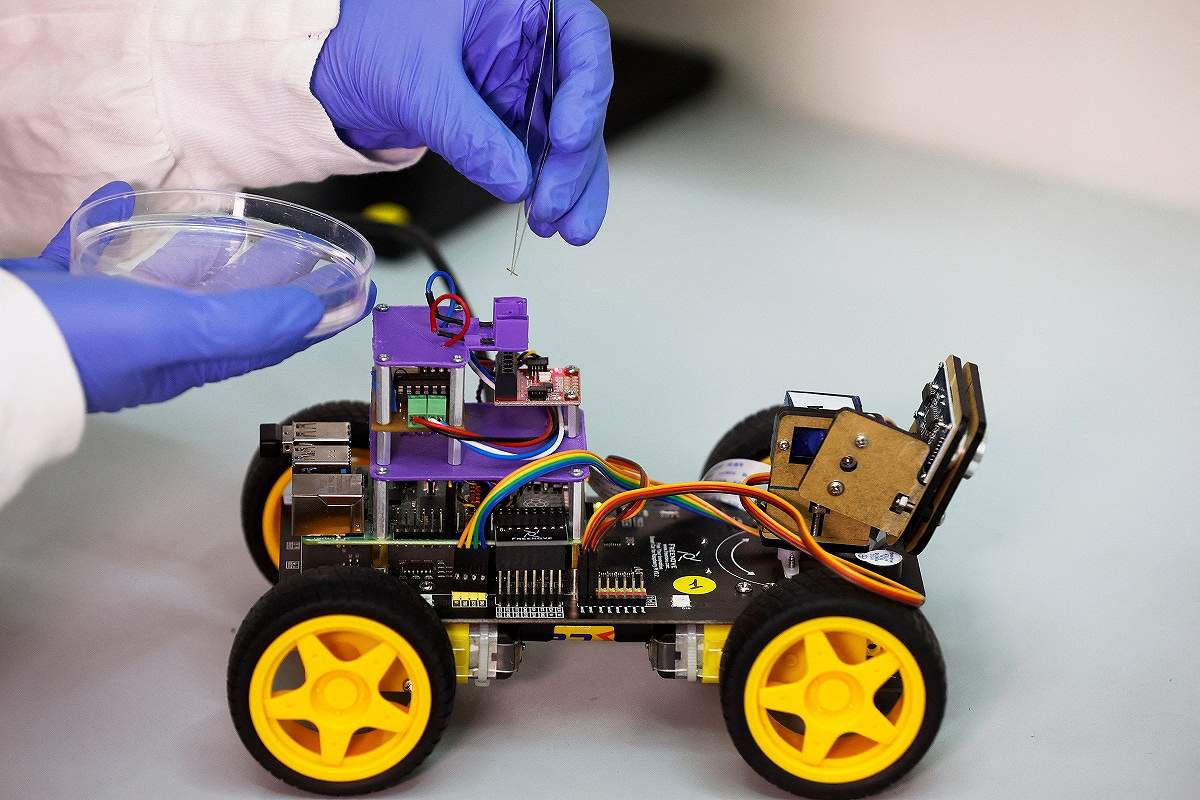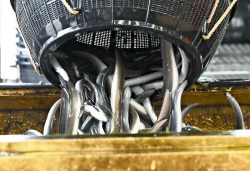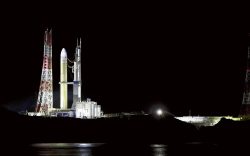
A scientist fits a locust antenna to a newly-developed robot, which allows it to detect and identify odors, at Tel Aviv University, on Jan. 25.
Reuters
13:53 JST, March 2, 2023
TEL AVIV (Reuters) — A new sniffing robot equipped with a biological sensor that uses the antennae of locusts could help advance disease diagnosis and improve security checks, its Israeli developers said.
Locusts have an acute sense of smell, which the researchers in Tel Aviv University have managed to harness to their bio-hybrid robot, making it far more sensitive than existing electronic sniffers, they said.
Locusts smell with their antennae. On the four-wheeled robot, the researchers placed the insect’s antenna between two electrodes that send electrical signals as a response to a nearby odor. Each scent has a unique signature which, with machine learning, the robot’s electronic system can identify.
“Ultimately, we are trying to create a robot with a sense of smell that will be able to distinguish between smells and to locate them in space,” said Neta Shvil of the Sagol School of Neuroscience.
Popular Articles
Popular articles in the past 24 hours
-

Japan Set to Participate in EU's R&D Framework, Aims to Boost Coo...
-

Nagano Pref. Village to Introduce Fines for Some Disruptive Behav...
-

Bullet Train Bento Features Herring, Salmon, Squid to Celebrate H...
-

9 Officers of Japan’s Hyogo Prefectural Police Suspected of Gambl...
-

Earthquake Damage Estimates Report Highlights Challenges Faced by...
-

M5.5 Earthquake Hits Japan’s Aomori and Iwate Prefectures; No Tsu...
-

Santa Claus Delivers Christmas Presents to Penguins at Aquarium i...
-

My Husband is Extraordinarily Strict with our Daughter, Who is St...
Popular articles in the past week
-

Israeli Tourists Refused Accommodation at Hotel in Japan’s Nagano...
-

Tsukiji Market Urges Tourists to Avoid Visiting in Year-End
-

China to Impose Sanctions on Shigeru Iwasaki, Former Head of Japa...
-

U.S. Senate Resolution Backs Japan, Condemns China's Pressure
-

Japan to Support Central Asian Logistics Route That Bypasses Russ...
-

Speed Skater Yukino Yoshida Clinches Ticket to Milan
-

Kenta Maeda Joins Rakuten Eagles; Returns from American MLB to Ja...
-

Sharp Decline in Number of Chinese Tourists But Overall Number of...
Popular articles in the past month
-

Keidanren Chairman Yoshinobu Tsutsui Visits Kashiwazaki-Kariwa Nu...
-

Imports of Rare Earths from China Facing Delays, May Be Caused by...
-

University of Tokyo Professor Discusses Japanese Economic Securit...
-

Japan Pulls out of Vietnam Nuclear Project, Complicating Hanoi's ...
-

Govt Aims to Expand NISA Program Lineup, Abolish Age Restriction
-

Blanket Eel Trade Restrictions Rejected
-

Key Japan Labor Group to Seek Pay Scale Hike
-

M4.9 Earthquake Hits Tokyo, Neighboring Prefectures
"Science & Nature" POPULAR ARTICLE
-

Genome Study Reveals Milestone in History of Cat Domestication
-

Big Leap in Quest to Get to Bottom of Climate Ice Mystery
-

Security Camera Footage Vulnerable to Outside Access; Investigation Finds 3,000 Pieces Exposed Online
-

Paws on Parade: Nairobi’s Dogs Dazzle at ‘Pawchella’
-

Japanese Eels Escape New Regulation in Vote at CITES Meeting, Avoiding Higher Prices for Dealers and Diners
JN ACCESS RANKING
-

Keidanren Chairman Yoshinobu Tsutsui Visits Kashiwazaki-Kariwa Nuclear Power Plant; Inspects New Emergency Safety System
-

Imports of Rare Earths from China Facing Delays, May Be Caused by Deterioration of Japan-China Relations
-

University of Tokyo Professor Discusses Japanese Economic Security in Interview Ahead of Forum
-

Japan Pulls out of Vietnam Nuclear Project, Complicating Hanoi’s Power Plans
-

Govt Aims to Expand NISA Program Lineup, Abolish Age Restriction







